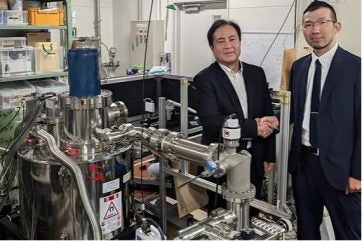
Japanese start-up Helical Fusion aims to launch the world’s first steady-state nuclear fusion reactor in 2034 and to begin commercial operations in the 2040s, CEO Takaya Taguchi told Reuters. “We aim to have the world’s first steady-state fusion reactor up and generating electricity within the next 10 years,” he said. “If successful, Japan, an energy importer, could produce its own energy and even export it, greatly enhancing Japan’s energy security.”
In March, Helical Fusion conducted a critical test involving a 19kA current in its proprietary High-Temperature Superconductor (HTS) cable. Helical said this “positions the company at the forefront of achieving a steady-state fusion reactor, establishing a new standard in the fusion energy domain”.
Helical Fusion, together with Japan’s National Institute for Fusion Science (NIFS), has developed a new HTS conductor, Wind & Impregnated Stacked Elastic (WISE) tapes, that can be scaled and engineered into high-performance magnets
In October 2023 Helical Fusion was selected by the Japanese Ministry of Education, Culture, Sports, Science & Technology (MEXT) for its total JPY 6.5bn ($43m) Small Business Innovation Research (SBIR) programme to develop cutting-edge fusion technologies. Helical Fusion was one of four companies to be selected to receive JPY2bn. The funding will accelerate commercialisation of the WISE conductor by increasing its Technology Readiness Level.
The company was founded in 2021 by Taguchi, a former banker, and two scientists from NIFS, which owns one of the world’s largest fusion experimental facilities that has achieved 100 million degrees Celsius and plasma durations over 3,000 seconds.
Helical Fusion plans to build a pilot reactor with a generation capacity of 50-100 megawatts. “If we run the pilot reactor starting in 2034 for a few years … we could begin building a commercial reactor and have it operational in around 2040 at the earliest,” he told Reuters.
He said significant challenges remain, including raising JPY1,000bn to build the pilot reactor, developing high-temperature superconductivity technology for coils, and establishing safety rules to gain local construction approval.
The planned reactor could be a type of stellarator known as a heliotron. This comprises two continuous helical coils capable of operating without a plasma current, similar to the Large Helical Device at NIFS. The proposed helical fusion reactor would use a unique design in which the magnetic field required for plasma confinement is generated solely by electromagnetic coils. This allows for stable plasma confinement over long periods.
In April, Helical began joint research with Professor Komurasaki at Toyko University’s Department of Aeronautics and Astronautics on optimisation and mass production of gyrotrons through advanced simulation techniques. The gyrotrons would be used to heat the plasma in the helical-stellarator.






